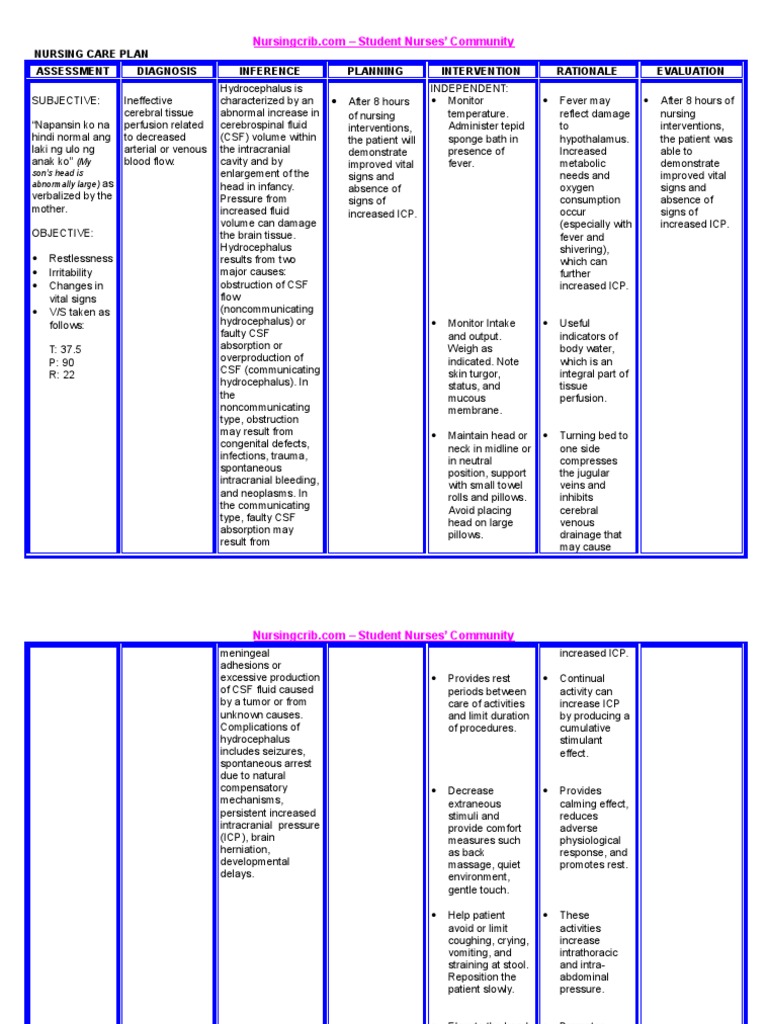NCP Nursing Care Plans for Meningitis. In meningitis, the brain and the spinal cord meninges become inflamed. Such inflammation may involve all three meningeal membranes: the dura mater, arachnoid membrane, and pia mater. For most patients, meningitis follows the onset of respiratory symptoms: In about 50% of patients, it develops over 1 to 7 days; in about 20% of patients, over 1 to 3 weeks. In about 25% of patients, meningitis is unheralded by respiratory symptoms; it has a sudden onset, causing serious illness within 24 hours.
Causes for Meningitis
Meningitis can be caused by bacteria, viruses, protozoa, or fungi. It most commonly results from bacterial infection, usually due to Neisseria meningitides, Haemophilus influenzae, Streptococcus pneumoniae, or Escherichia coli. Occasionally the causative organism can't be determined.
Complications for Meningitis
Potential complications of meningitis include:
- Visual impairment
- Optic neuritis
- Cranial nerve palsies
- Deafness
- Personality change
- Headache
- Paresis or paralysis
- Endocarditis
- Coma
- Vasculitis
- Cerebral infarction
- Children may develop sensory hearing loss, epilepsy, mental retardation, hydrocephalus, or subdural effusions.
Nursing assessment Nursing Care Plans for Meningitis
The cardinal signs of meningitis are those of infection and increased intracranial pressure (ICP).
The patient history may detail headache, stiff neck and back, malaise, photophobia, chills and, sometimes, vomiting, twitching, and seizures.
- Patient history varies according to which form of meningitis the patient has: acute or subacute. For the subacute form, the patient or family may describe vague, mild symptoms such as irritability, loss of appetite, and headaches. With an acute infection, there may be reports of a headache that became progressively worse, with accompanying vomiting, disorientation, or delirium. The patient may also note an increased sensitivity to light (photophobia), chills, fever, and even seizure activity. Frequently the patient or family describes a recent upper respiratory or other type of infection. A patient with pneumococcal meningitis may have had a recent ear, sinus, or lung infection or endocarditis.
- Physical Assesment findings vary, depending on the severity of the meningitis. You may note opisthotonus, (a spasm in which the back and extremities arch backward so that the body rests on the head and heels), a sign of meningeal irritation. In meningococcal meningitis, you may see a petechial, purpuric, or ecchymotic rash on the lower part of the body. Neurologic examination may uncover other indications of meningeal irritation, including positive Brudzinski's and Kernig's signs and exaggerated and symmetrical deep tendon reflexes. It may also reveal altered LOC, ranging from confusion or delirium to deep stupor or coma. Vision testing may reveal diplopia and other visual problems. Ophthalmoscopic examination may show papilledema (another sign of increased ICP), but this is rare.
Diagnostic tests for Meningitis
- Lumbar puncture cerebrospinal fluid (CSF)
- Chest X-rays
- White blood cell count
- Computed tomography scanning.
Nursing diagnoses Nursing Care Plans for Meningitis
Common nursing diagnosis found in nursing Care Plans for meningitis
- Acute pain
- Anxiety
- Hyperthermia
- Impaired gas exchange
- Risk for deficient fluid volume
- Risk for impaired skin integrity
Nursing outcomes Nursing Care Plans for Meningitis
- The patient will express feelings of comfort and relief of pain.
- The patient will identify strategies to reduce anxiety.
- The patient will exhibit temperature within normal range.
- The patient will maintain adequate ventilation and oxygenation.
- The patient will maintain fluid volume within normal range.
- The patient's skin integrity will remain intact.
Nursing interventions Nursing Care Plans for Meningitis
- Pain Management: Alleviation of pain or a reduction in pain to a level of comfort that is acceptable to the patient
- Analgesic Administration: Use of pharmacologic agents to reduce or eliminate pain
- Environmental Management: Comfort: Manipulation of the patient’s surroundings for promotion of optimal comfort
- Anxiety Reduction: Minimizing apprehension, dread, foreboding, or uneasiness related to an unidentified source or anticipated danger
- Calming Technique: Reducing anxiety in patient experiencing acute distress
- Temperature Regulation: Attaining and/or maintaining body temperature within a normal range
- Fever Treatment: Management of a patient with hyperpyrexia caused by non environmental factors
- Malignant Hyperthermia Precautions: Prevention or reduction of hyper metabolic response to pharmacological agents.
- Respiratory Monitoring: Collection and analysis of patient data to ensure airway patency and adequate gas exchange
- Oxygen Therapy: Administration of oxygen and monitoring of its effectiveness
- Airway Management: Facilitation of patency of air passages
- Fluid Monitoring: Collection and analysis of patient data to regulate fluid balance
- Hemodynamic Regulation: Optimization of heart rate, preload, afterload, and contractility
- Skin Surveillance: Collection and analysis of patient data to maintain skin and mucous membrane integrity
- Pressure Management: Minimizing pressure to body parts
- Pressure Ulcer Prevention: Prevention of pressure ulcers for a patient at high risk for developing them
